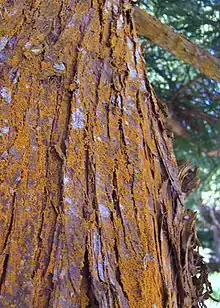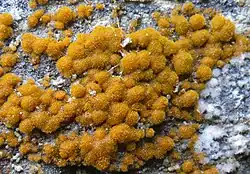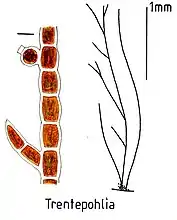Trentepohlia (alga)
Trentepohlia is a genus of filamentous chlorophyte green algae in the family Trentepohliaceae, living free on terrestrial supports such as tree trunks and wet rocks or symbiotically in lichens.[2] The filaments of Trentepohlia have a strong orange colour (photograph at right) caused by the presence of large quantities of carotenoid pigments which mask the green of the chlorophyll.
| Trentepohlia | |
|---|---|
 | |
| Trentepohlia sp. on Cryptomeria japonica bark | |
| Scientific classification | |
| (unranked): | Viridiplantae |
| Division: | Chlorophyta |
| Class: | Ulvophyceae |
| Order: | Trentepohliales |
| Family: | Trentepohliaceae |
| Genus: | Trentepohlia Mart. |
| Type species | |
| Trentepohlia aurea | |
| Species[1] | |
| |
| Synonyms | |
| |
Trentepohlia species form associations with fungal hyphae, and are widespread phycobionts in lichens, such as the "secret writing" crustose lichen genera Graphis, Graphina, Gyalecta and Opegrapha.[3][4]
There are about 40 species of Trentepohlia mostly distributed in tropical and subtropical areas[5] but several species also occur in temperate environments including Britain and Ireland.[6] The genus is present in almost all continents.[7]
The genus was circumscribed by Carl Friedrich Philipp von Martius in Fl. Crypt. Erlang. on page 351 in 1817.
The genus name of Trentepohlia is in honour of Johann Friedrich Trentepohl (1748–1806), who was a German clergyman and botanist. He worked as a lecturer and Pastor in various places in Wesermarsch.[8]
Gallery
 Trentepohlia aurea, Tauberland, Germany
Trentepohlia aurea, Tauberland, Germany.jpg.webp) Trentepohlia aurea var. polycarpa grows prolifically on Monterey Cypress trees at Point Lobos, California
Trentepohlia aurea var. polycarpa grows prolifically on Monterey Cypress trees at Point Lobos, California Illustration
Illustration
References
- M.D. Guiry in Guiry, M.D. & Guiry, G.M. 2018. AlgaeBase. World-wide electronic publication, National University of Ireland, Galway. http://www.algaebase.org/search/genus/detail/?genus_id=X34e5de6b47fb6fc9 ; searched on 28 June 2018.
- See the NCBI webpage on Trentepohlia. Data extracted from the "NCBI taxonomy resources". National Center for Biotechnology Information. Retrieved 2007-03-19.
- F.S. Dobson (2000) Lichens, an illustrated guide to the British and Irish species. Richmond publishing Co. ISBN 0-85546-094-6
- T. Friedl and B. Büdel (1996) Photobionts, in Nash, T.H. (ed.) Lichen biology, pp.8-23, Cambridge University Press.
- van den Hoek, C.; Mann, D.G.; Jahns, H.M. (1995). Algae: an introduction to phycology. Cambridge: Cambridge University Press. ISBN 9780521316873.
- John, D.M.; Whitton, B.A.; Brook, A.J., eds. (2002). The freshwater algal flora of the British Isles. Cambridge, U.K.: Cambridge University Press. ISBN 9780521193757.
- Aboal, Marina; Egidos, Ana; Marín, José; Asencio, Antonia (2002). "Trentepohlia jolithus (L.) Wallroth 1833 (Chlorophyta, Ulvophyceae) in subaerial habitats from southeastern Spain". Archiv für Hydrobiologie. Algological Studies. 107: 153–162.
- Burkhardt, Lotte (2022). Eine Enzyklopädie zu eponymischen Pflanzennamen [Encyclopedia of eponymic plant names] (pdf) (in German). Berlin: Botanic Garden and Botanical Museum, Freie Universität Berlin. doi:10.3372/epolist2022. ISBN 978-3-946292-41-8. S2CID 246307410. Retrieved January 27, 2022.
![]() Media related to Trentepohlia at Wikimedia Commons
Media related to Trentepohlia at Wikimedia Commons